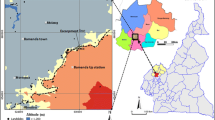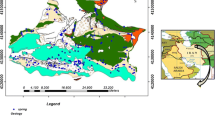Abstract
Land subsidence causes many problems, including faulting of Earth's surface, damage irrigation systems, reduced soil fertility, misalignment and failure of the walls of wells, changes of river courses and roadways, and even damages in residential areas and agricultural lands. This study assesses groundwater changes using the Google Earth Engine (GEE) and land-subsidence susceptibility (LSS) on the Gharabolagh Plain in Fars Province, Iran, using two probabilistic models, evidential belief function (EBF) and Bayesian theory (BT). In extensive field surveys, the land-subsidence points identified in the study area were recorded by handheld GPS. A land-subsidence location map (LSIM) was prepared in ArcGIS 10.6.1. The sites were divided into two sets: 70% of the subsidence points locations to be used for modeling (calibration) and 30% to be used for testing (validation) of the models. Effective factors that promote land-subsidence occurrence (LSO) were selected and maps for each were prepared from several sources—topographical and geological maps, and satellite images. Changing groundwater level was determined from the GEE platform using GRACE satellite images from a 14-year period. Three methods—CSR (Center for Space Research at the University of Texas), JPL (Jet Propulsion Laboratory), and GFZ (German Research Centre for Geosciences)—were employed and show that the greatest changes in water depth in the study area are equal to − 16.55, − 17.77, and − 15.09 cm from CSR, GFZ, and JPL, respectively. The spatial relationships between land subsidence and the ten effective factors were assessed using the EBF algorithm and BT. Also, analysis of variables importance was done using the random forest model. Prioritizing these factors, it was revealed that excessive withdrawal of groundwater, elevation, and distance from rivers were the most important variables promoting subsidence. Finally, the LSS maps were prepared in GIS. The validation analysis of the two probability models by ROC curve revealed that EBF had 93.2% accuracy and BT was 99.8% accurate. The maps generated with both models can effectively indicate LSS for managers of groundwater and can be used to prevent fatalities, financial losses, and damage to property caused by this phenomenon.







Similar content being viewed by others
References
Abdollahi S, Pourghasemi HR, Ghanbarian GhA, Safaeian R (2018) Prioritization of effective factors in the occurrence susceptibility mapping using an SVM model and their different Kernel functions. Bull Eng Geol Env. https://doi.org/10.1007/s10064-018-1403-6
Ahrari AH (2019) Virtual engine of satellite image processing, Tehran, Publisher: Kilide Amozesh p. 248. (In Persian).
Arabameri A, Cerda A, Tiefenbacher JP (2019) Spatial pattern analysis and prediction of gully erosion using novel hybrid model of entropy-weight of evidence. Water 11(6):1129. https://doi.org/10.3390/w11061129
Arabameri A, Saha S, Roy J, Tiefenbacher JP, Cerda A, Biggs T, Collins AL (2020) A novel ensemble computational intelligence approach for the spatial prediction of land subsidence susceptibility. Sci Total Environ 726:138595. https://doi.org/10.1016/j.scitotenv.2020.138595
Bonham-Carter GF (1994) Geographic information systems for geoscientists: modelling with GIS, comp. Meth Geos 13: Pergamon, New York, p 398.
Carranza EJM (2009) Controls on mineral deposit occurrence inferred from analysis on their spatial pattern and spatial association whit Geological features. Ore Geol Rev 35(3–4):383–400
Carranza EJM, Woldai T, Chikambwe EM (2005) Application of data-driven evidential belief functions to prospectively mapping for aquamarine-bearing pegmatite, Lundazi District, Zambia. Nat Resour Res 14:47–63
Catani F, Lagomarsino D, Segoni S, Tofani V (2013) Landslide susceptibility estimation by random forests technique: sensitivity and scaling issues. Nat Haz Earth Syst Sci 13:2815–2831
Chen W, Pourghasemi HR, Kornejadi A, Ning Zh (2017) Geographic landslide spatial modeling: introducing new ensembles of ANN, MaxEnt, and SVM machine learning techniques. Geoderma 305:314–327
Ghorbanzadeh O, Blaskche T, Feizizadeh B (2018) An interval matrix method used to optimize the decision matrix in AHP technique for land subsidence susceptibility mapping. Environ Earth Sci 77:584
Ghorbanzadeh O, Gholamnia Kh, Blaskche T, Jagannath A (2018) A new GIS-based data mining technique using an adaptive neuro-fuzzy inference system (ANFIS) and k-fold cross validation approach for land subsidence susceptibility mapping. Nat Haz 94:497–517
Ghorbanzadeh O, Jagannath A, Blaskche T, Gholamnia Kh (2018) A new GIS-based technique using an adaptive neuro-fuzzy inference system for land subsidence susceptibility mapping. J Spat Sci. https://doi.org/10.1080/14498596.2018.1505564
Jebur NM, Pradhan B, Shafapour Tehrany M (2014) Manifestation of LiDAR-derived parameters in the spatial prediction of landslides using novel ensemble evidential belief functions and support vector machine models in GIS. IEEE J Select Top Appl Earth Obser Remote Sens 8(2):674–690
Kidanu S, Anderson J, Rogers D (2018) Using GIS-based spatial analysis to determine factors influencing the formation of sinkholes in Greene County, Missouri. Environ Eng Geosci 132:1–11
Lee S, Park I, Choi J-K (2012) Spatial prediction of ground subsidence susceptibility using an artificial neural network. Environ Manage 49:347–358
Lee J-H, Sameen MI, Pradhan B, Park H-J (2018) Modeling landslide susceptibility in data-scarce environments using optimized data mining and statistical methods. Geomorphology 303:284–298. https://doi.org/10.1016/j.geomorph.2017.12.007
Matova M, Frangov G, Yotov I, Ivanov P, Petkovski P, Aliaj S (1999) UNESCO-BAS Project of land subsidence research in the regions of Sofia Scopje and Tirana cities. - International Union of Geological Sciences, COGEOENVIRONMENT, Geoindicators. Workshop in Vilnius, Lithuania, October 11–16, 1999. Abstracts, pp 31–34
Mohammady M, Pourghasemi HR, Amiri M (2019) Land subsidence susceptibility assessment using random forest machine learning algorithm. Environ Earth Sci 78:503. https://doi.org/10.1007/s12665-019-8518-3
Nadiri A, Taheri Z, Khatibi R, Barzegari Gh, Dideban Kh (2018) Introducing a new framework for mapping subsidence vulnerability indices (SVIs). ALPRIFT. Sci Total Environ 52(1):1043–1057
Nampak H, Pradhan B, Manap MA (2014) Application of GIS based data driven evidential belief function model to predict groundwater potential zonation. J Hydrol 513:283–300
Nandi A, Shakoor A (2010) A GIS-based landslide susceptibility evaluation using bivariate and multivariate statistical analyses. Eng Geol 110:11–20
Oh HJ, Lee S (2010) Assessment of ground subsidence using GIS and the weights-of-evidence model. Eng Geol 115(1–2):36–48. https://doi.org/10.1016/j.enggeo.2010.06.015
Ozdemir A (2015) Investigation of sinkholes spatial distribution using the weights of evidence method and GIS in the vicinity of Karapinar (Konya, Turkey). Geomorphology 245:40–50
Ozdemir A (2016) Investigation of sinkholes spatial distribution using the weights of evidence method and GIS in the vicinity of Karapinar (Konya, Turkey). Geomorphology 245:40–50
Park P, Lee J, Lee S (2014) Ensemble of ground subsidence hazard map using fuzzy logic. Geoscience 83:207–218
Paudel U, Oguchi T (2014) Implementation of random forest in landslide susceptibility study, a case study of the Tokamachi area, Niigata, Japan. In: Japan Geoscience Union Meeting, Pcaifico Yokohama, 28th April 2nd May, 2014.
Pourghasemi HR, Moradi HR, Mohammadi M, Pradhan B, Mostafazadeh R, Goli Jirandeh A (2012) Landslide hazard assessment using remote sensing data, GIS and weightsof-evidence model (South of Golestan Province, Iran). Asia Pacific Conference on Environmental Science and Technology (APEST 2012), Advances in Biomedical Engineering, Environmental Science and Technology, vol 6, pp 30–36
Pourghasemi HR, Moradi HR, Fatemi Aghda SM (2013) Landslide susceptibility mapping by binary logistic regression, analytical hierarchy process, and statistical index models and assessment of their performances. Nat. Hazards 69:749–777
Pourghasemi HR, Rahmati A (2018) Rapid GIS-based spatial and regional modelling of landslide susceptibility using machine learning techniques in the R open source software. CATENA 162:177–192
Tien Bui D, Shahabi H, Shirzadi A, Chapi K, Pradhan B, Chen W, Khosravi K, Panahi M, Bin Ahmad B, Saro L (2018) Land subsidence susceptibility mapping in South Korea using machine learning algorithms. Sensors 18:2464
Pradhan B, Abokharima MH, Neamah Jebur M, Shafapour Tehrany M (2014) Land subsidence susceptibility mapping at Kinta valley (Malaysia) using evidential belief model in GIS. Natural Hazard 73:1019–1042
Rahmati O, Pourghasemi HR (2017) Identification of Ccritical flood prone areas in data-scarce and ungauged regions: a comparison of three data mining models. Water Resour Manage 31:1473–1487
Regmi N, Gaedino JR, Vitek JD (2015) Modeling susceptibility to landslides using the weight of evidence approach: western Colorado, USA. Geomorphology 115:172–187
Stephan AN (2016) Subsidence: dissolution and human related causes. https://www.tulane.edu/~sanelson/Natural_Disasters/subsidence.pdf
Stumpf A, Kerle N (2011) Object-oriented mapping of landslides using random forests. Remote Sens Environ 115:2564–2577
Swenson SC, Wahr J (2006) Post-processing removal of correlated errors in GRACE data. Geophys Res Lett 33: L08402. https://doi.org/10.1029/2005GL025285s
Swenson SC (2012) GRACE monthly land water mass grids NETCDF RELEASE 5.0. Ver. 5.0. PO.DAAC, CA, USA. Dataset accessed at https://doi.org/10.5067/TELND-NC005
Tehrany MS, Kumar L (2018) The application of a Dempster–Shafer-based evidential belief function in flood susceptibility mapping and comparison with frequency ratio and logistic regression methods. Environ Earth Sci 77(13):1–24. https://doi.org/10.1007/s12665-018-7667-0
Wilson WL, Beck BF (1992) Hydrogeologic factors in affecting new sinkhole development in the Orlando area, Florida. Groundwater 30(6):918–930
Xie Z, Chen G, Meng X, Zhang Y, Qiao L, Tan L (2017) A comparative study of landslide susceptibility mapping using weight of evidence, logistic regression and support vector machine and evaluated by SBASInSAR monitoring: Zhouqu to Wudu segment in Bailong River Basin, China. Environ Earth Sci 76:313
Yamani M, Najafi E, Abedini MH (2001) The relationship between ground subsidence and groundwater drop in Ghare- Bolgh Plain (Fars Province). Geography 3(8–9):9–27 ([In Persian])
Yesilnacar EK (2005) The application of computational intelligence to landslide susceptibility mapping in Turkey, PhD Thesis. Department of Geomatics the University of Melbourne 2005, p 423
Yilmaz I, Marschalko M, Bednarik M (2013) An assessment on the use of bivariate, multivariate and soft computing techniques for collapse susceptibility in GIS environment. J Earth Syst Sci 122:371–388
Yin J, Yu D, Wilby R (2016) Modelling the impact of land subsidence on urban pluvial flooding; a case study of downtown Shanghai, China. Sci Total Environ 544:744–753
Youssef AM, Pourghasemi HR, Pourtaghi ZS, Al-Katheeri MM (2015) Landslide susceptibility mapping using random forest, boosted regression tree, classification and regression tree, and general linear models and comparison of their performance at Wadi Tayyah Basin, Asir Region, Saudi Arabia. Landslides. https://doi.org/10.1007/s10346-015-0614-1
USGS (United States Geological Survey), Land subsidence in the United States (2000). https://water.usgs.gov/ogw/pubs/fs00165/SubsidenceFS.v7.PDF, USGS Fact Sheet-165-00, December 2000
Acknowledgements
The study was supported by the College of Agriculture, Shiraz University, and Grant No. 98GRC1M271143. Also, the authors would like to thank the Editor-in-Chief (Prof. Dr. Olaf Kolditz) and the five anonymous reviewers for their positive comments.
Author information
Authors and Affiliations
Corresponding author
Ethics declarations
Conflicts of interest
The authors declare no conflict of interest.
Additional information
Publisher's Note
Springer Nature remains neutral with regard to jurisdictional claims in published maps and institutional affiliations.
Rights and permissions
About this article
Cite this article
Najafi, Z., Pourghasemi, H.R., Ghanbarian, G. et al. Land-subsidence susceptibility zonation using remote sensing, GIS, and probability models in a Google Earth Engine platform. Environ Earth Sci 79, 491 (2020). https://doi.org/10.1007/s12665-020-09238-2
Received:
Accepted:
Published:
DOI: https://doi.org/10.1007/s12665-020-09238-2




